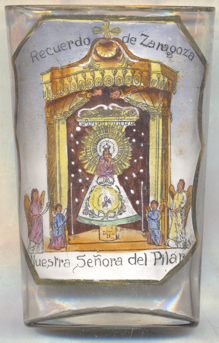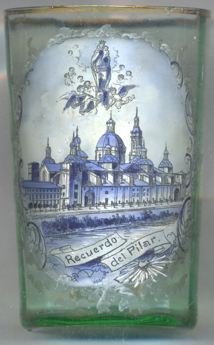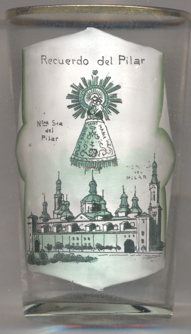

|
| ESPAÑA | Spain |
| Aragón | Aragon |
| Provincia: Zaragoza | Saragossa |
Zaragoza is the capital city of the Zaragoza province and of the autonomous community of Aragón. It is situated at an elevation of 243 m on the Ebro river and its tributaries, the Huerva and the Gállego, roughly in the center of both Aragón and the Ebro basin. With two monuments (the tower and parish church of San Pablo, and apse, parish and dome of La Seo), Zaragoza is part of the UNESCO World Heritage Site "Mudéjar Architecture of Aragon" (listed in 1989: Teruel; Calatayud, Cervera de la Cañada, Tobed and Zaragoza added in 2001).

 The Sedetani, a tribe of ancient Iberians, populated a village called Salduie (Salduba in Roman sources). The Romans,
under emperor Augustus, founded a city called Caesaraugusta in ca. 25–12 BC. the city was captured peacefully by the
Goths in the 5th century AD. From 1018 to 1118 Zaragoza was one of the taifa kingdoms, independent Muslim states which emerged in
the 11th century following the destruction of the Cordoban Caliphate. In 1118 the Aragonese conquered the city from the Almoravids
and made it the capital of the Kingdom of Aragón. When King Alfonso I of Aragón and Navarra died without heirs in 1134,
Zaragoza was swiftly occupied by Alfonso VII of León and Castile. Zaragoza suffered two famous sieges during the Peninsular War against the Napoleonic army:
a first from June to August 1808; and a second from December 1808 to February 1809.
Despite a decline in the outlying rural economy, Zaragoza has continued to grow. Today, the municipality of Zaragoza has a population
of about 665,000 (2015), making it 5th in Spain and 32nd most populous municipality in the European Union.
The Sedetani, a tribe of ancient Iberians, populated a village called Salduie (Salduba in Roman sources). The Romans,
under emperor Augustus, founded a city called Caesaraugusta in ca. 25–12 BC. the city was captured peacefully by the
Goths in the 5th century AD. From 1018 to 1118 Zaragoza was one of the taifa kingdoms, independent Muslim states which emerged in
the 11th century following the destruction of the Cordoban Caliphate. In 1118 the Aragonese conquered the city from the Almoravids
and made it the capital of the Kingdom of Aragón. When King Alfonso I of Aragón and Navarra died without heirs in 1134,
Zaragoza was swiftly occupied by Alfonso VII of León and Castile. Zaragoza suffered two famous sieges during the Peninsular War against the Napoleonic army:
a first from June to August 1808; and a second from December 1808 to February 1809.
Despite a decline in the outlying rural economy, Zaragoza has continued to grow. Today, the municipality of Zaragoza has a population
of about 665,000 (2015), making it 5th in Spain and 32nd most populous municipality in the European Union.

 Nuestra
Nuestra


The  Cathedral-Basilica of Our Lady of the Pillar (Catedral-Basílica de Nuestra Señora del
Pilar) [left, no. 3639, and right, no. 3611], together with the Cathedral of the Savior (Catedral del Salvador or La Seo de Zaragoza)
the co-cathedral of Zaragoza, is reputed to be the first church dedicated to Mary in history. About a year after the
apparition, James is believed to have had a small chapel built in Mary's honor. This first chapel was eventually destroyed
with various other Christian shrines, but the statue and the pillar stayed intact under the protection of the people of
Zaragoza. Numerous churches have been built upon this site through the years. The tiny chapel built by Saint James later
gave way to a basilicalike enclosure during Roman times; subsequently being transformed into Romanesque, then Gothic then
Mudéjar styles. The Romanesque church was damaged by fire in 1434, and reconstruction began in the Mudéjar
Gothic style. A Gothic-style church was built in the 15th century but only a few parts of it remain intact or were
later restored. The present spacious church in Baroque style was begun in 1681 and completed in 1686. By 1718 the church had
been vaulted over. However, it was not until 1872 that the final touches were put to these vaults, when the main dome and
the final spire were finished. In 1725, the building was transformed into its present dimensions of 130 meters long by
67 m wide, with its eleven cupolas and four towers. The area most visited is the eastern part of the chapel which
houses the venerated image of the Virgin. During the Spanish Civil War of 1936–1939 three bombs were dropped on the
church but none of them exploded. Two of them are still on show in the Basilica.
Cathedral-Basilica of Our Lady of the Pillar (Catedral-Basílica de Nuestra Señora del
Pilar) [left, no. 3639, and right, no. 3611], together with the Cathedral of the Savior (Catedral del Salvador or La Seo de Zaragoza)
the co-cathedral of Zaragoza, is reputed to be the first church dedicated to Mary in history. About a year after the
apparition, James is believed to have had a small chapel built in Mary's honor. This first chapel was eventually destroyed
with various other Christian shrines, but the statue and the pillar stayed intact under the protection of the people of
Zaragoza. Numerous churches have been built upon this site through the years. The tiny chapel built by Saint James later
gave way to a basilicalike enclosure during Roman times; subsequently being transformed into Romanesque, then Gothic then
Mudéjar styles. The Romanesque church was damaged by fire in 1434, and reconstruction began in the Mudéjar
Gothic style. A Gothic-style church was built in the 15th century but only a few parts of it remain intact or were
later restored. The present spacious church in Baroque style was begun in 1681 and completed in 1686. By 1718 the church had
been vaulted over. However, it was not until 1872 that the final touches were put to these vaults, when the main dome and
the final spire were finished. In 1725, the building was transformed into its present dimensions of 130 meters long by
67 m wide, with its eleven cupolas and four towers. The area most visited is the eastern part of the chapel which
houses the venerated image of the Virgin. During the Spanish Civil War of 1936–1939 three bombs were dropped on the
church but none of them exploded. Two of them are still on show in the Basilica.
[https://en.wikipedia.org/wiki/Zaragoza, https://de.wikipedia.org/wiki/Saragossa,
https://en.wikipedia.org/wiki/Mudéjar_Architecture_of_Aragon;
https://en.wikipedia.org/wiki/Cathedral-Basilica_of_Our_Lady_of_the_Pillar,
https://en.wikipedia.org/wiki/Cathedral_of_the_Savior_of_Zaragoza;
https://en.wikipedia.org/wiki/Our_Lady_of_the_Pillar, https://en.wikipedia.org/wiki/Basilica_of_Our_Lady_of_the_Pillar]
![[scale]](lineal.jpg)